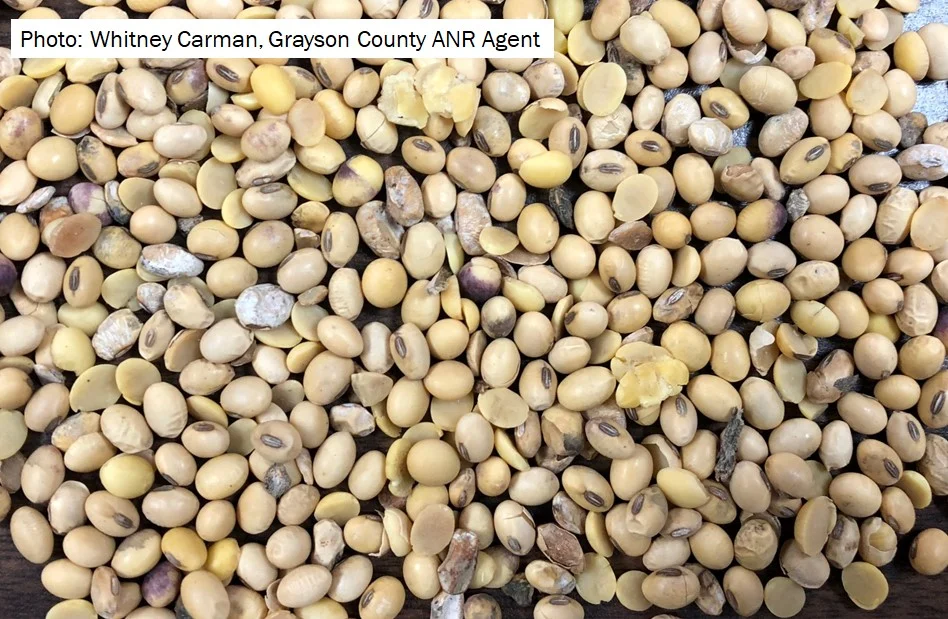Reducing the Impact of 2018 Soybean Seed Quality on the 2019 Soybean Crop
Dr. Carrie Knott— Extension Grain Crops Specialist
Figure 1. Soybean harvest in January 2019 in Fulton County, KY.
Unfortunately some Kentucky producers are still ‘battling’ the 2018 soybean harvest (Figure 1). The fact that several thousand acres of unharvested soybean still remain in Kentucky in February emphasizes the tremendous challenge for harvest of the 2018 soybean crop. This has had a real impact on the quality of those soybeans (Figure 2). As early as the first week of October, reports that there were some major problems with pathogens in Kentucky’s soybeans were being made. In most cases, the diseases were Phomopsis seed decay and purple seed stain. These diseases were favored by the repeated, frequent rains that occurred after the soybean crop was physiologically mature (Growth Stage R7; about 60% grain moisture), but before the crop could be harvested due to lots of rain and saturated soil conditions. Drs. Carl Bradley and Kiersten Wise, University of Kentucky plant pathologists, along with Dr. Daren Mueller of Iowa State University and Drs. Damon Smith and Shawn Conley of University of Wisconsin-Madison, wrote a very informative blog with much more specific details on those pathogens and potential management considerations for those pathogens: Soybean Seed Quality Considerations for 2019.
Figure 2. Soybean seed harvested in Central Kentucky in early October.
Near impossible harvest conditions were not isolated to Kentucky. Many of the regions that produce ‘seed beans’, the soybeans that were produced in 2018 and will be sold to farmers to produce the 2019 crop, also had similar challenges. Seed companies will certainly clean the soybean seed extensively so that only the highest possible quality product will be sold in 2019. However, seed quality problems may still persist and require additional efforts to effectively manage in 2019.
One concern is that soybean seed germination may be reduced due to the presence of pathogens (see Soybean Seed Quality Considerations for 2019) and/or the repeated, frequent rains that occurred after the soybean reached physiological maturity. There are no ‘rescues’ for low germination rates but understanding that in 2019 seeding rates will probably need to be increased to compensate for lower-than-normal germination rates will ensure that plant populations and ultimately, final yield are not impacted.
A second and much more concerning problem for the 2019 soybean crop is seed vigor. Seed vigor is a measure of the ability of seeds to produce normal seedlings in stressful conditions. This differs from seed germination, which is how many seeds can produce normal seedlings under ideal conditions. There are very few ideal soybean fields in Kentucky making seed vigor very important. In most years, seed germination and seed vigor are quite high and there is no need for concern. However, seed vigor can be greatly reduced when subjected to repeated, frequent rains after the R7 growth stage; the EXACT conditions that occurred across much of the soybean seed production region in 2018.
Seed vigor is not listed on the seed tag, but it can be tested at many laboratories across the nation, including the University of Kentucky Regulatory Services. In general, the seed vigor test for soybean is the Accelerated Aging test. This test takes a minimum of 10 days to complete. This does not include any backlog the laboratory may have at the time the sample is submitted. Therefore, submitting samples as soon as possible is important to allow time to obtain the test results and make management decisions that will not impact planting dates.
In general, the test results will list the seed vigor as “High” or “Low”. Essentially, seed lots with “High” seed vigor will likely produce acceptable germination and emergence rates in less than ideal conditions, such as cool, wet soils. Conversely, “Low” vigor seed lots are not expected to produce adequate, uniform stands unless field conditions are ideal, i.e. soil temperature between 68 and 86°F with no moisture stress (see Chapter 4 in A Comprehensive Guide to Soybean Management in Kentucky for additional details). “Low” vigor seed lots generally produce initial plant stands with unacceptable plant populations (less than 100,000 plants per acre) because much less seedlings will become established than would be predicted from the seed germination rate alone. This situation often results in reduced profitability at the end of the season due to the need for re-planting and in some cases reduced yield potential of the later-planted replant.
It is impossible to predict future growing seasons and what, if any, challenges may be encountered. However, given what we know about seed quality and the 2018 harvest season, it is reasonable to assume that farmers may be starting the 2019 with the considerable challenge of ensuring that their 2019 soybean seed lots are acceptable for their specific planting conditions. To minimize any potentially negative impacts, farmers will likely need to adjust seeding rates according the labeled seed germination rates and will certainly need to determine seed vigor of ALL soybean seed lots. If a seed lot has “Low” vigor, do not use in conditions that are less than ideal. It may even be worth acquiring a different seed lot that is known to have “High” vigor to reduce the likelihood of inadequate stands, and the need for re-planting due to seed source.


